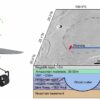Australian astronomers have provided vital information in the global effort to understand the brightest-ever detected gamma ray burst, which swept through our solar system on October 9 last year.
Detailed findings of that explosion from another galaxy 1.9 billion light years away were published today in The Astrophysical Journal Letters.
Ph.D. student James Leung from the University of Sydney said, “The exceptional brightness of this gamma-ray burst meant astronomers were able to study it in unprecedented detail in real-time as the light arrived from that distant galaxy.
“This gave us a golden opportunity to test intricate physical models that describe what happens before, during and after the death of a star.”
Mr. Leung is co-author of a complementary study currently published on the pre-print server arXiv and submitted for publication in Nature Astronomy.
Scientists believe gamma ray bursts—the brightest known explosions in the Universe—are the death throes of enormous stars as they collapse into black holes, emitting enormous amounts of energy in opposite directions as gamma rays and X-rays.
At the time of its detection last year, the gamma ray burst GRB 221009A was dubbed as BOAT—the brightest of all time.
“While that’s a bit of an exaggeration, GRB 221009A was likely the brightest burst at X-ray and gamma-ray energies to occur since human civilisation began,” said Assistant Professor Eric Burns at Louisiana State University in Baton Rouge and co‑author of The Astrophysical Journal Letters study.
The burst was so bright it blinded most gamma-ray instruments in space, which meant they could not measure the real intensity of the emission.
Astronomers believe it to be a one in 10,000-year event. And while the energy from this gamma ray burst was not unusually large, the jets of energy were exceptionally narrow with one pointed directly at Earth, making it appear exceptionally bright.
Working with scientists from the University of Oxford, the University of Sydney and the Curtin University node of the International Centre for Radio Astronomy Research, the astronomers provided vital and rapid follow-up observation of the cosmic event in the radio wave part of the electromagnetic (light) spectrum.
This supported work by US astronomers piecing together missing data in shorter wavelengths (X-ray and gamma ray) using NASA’s Fermi Gamma-ray Space Telescope and data collected from Russian and Chinese teams. Together they showed the burst was 70 times brighter than any seen before.
University of Sydney scientists provided follow-up observation of the gamma ray burst using the CSIRO ASKAP telescope in Western Australia, detecting the effects of the dramatic emission of energy at longer radio wavelengths.
Professor Tara Murphy, Head of the School of Physics at the University of Sydney and co-author on the Oxford University-led radio astronomy research, said, “One of the fascinating things about gamma ray bursts is, although they are over quite quickly—in just a matter of seconds—they leave afterglow emissions across the light spectrum in surrounding matter that echo for months and years afterwards.”
Co-author and Sydney Ph.D. student James Leung said, “This afterglow is produced by a forward shock from the material ejected by the gamma-ray burst and a reverse shock reflected backwards into the ejected material. This gives us further opportunities to observe these fascinating, powerful events.”
Their observations showed a rapid, early brightening from the source of the event caused by the reverse shock of the gamma ray burst. This revealed evidence in radio waves that is difficult to explain within current theoretical explanations of gamma ray bursts.
Mr. Leung said, “Our observations provide unmatched insights into the reverse shock model for gamma-ray burst emission, showing it is very difficult for existing models to replicate the slow evolution of the energy peaks that we observed.
“This means we have to refine and develop new theoretical models to understand these most extreme explosions in the Universe.”
This detective work will help astronomers quickly pinpoint future gamma ray bursts, perhaps assisting in the discovery of predicted supernovae associated with the events.
Co-author of the Oxford-led study, Dr. Gemma Anderson (ICRAR-Curtin University), said, “The most interesting part of a cosmic explosion is the very beginning as the explosion expels material that is moving at nearly the speed of light. We therefore want the radio telescopes to be on target and observing GRBs as quickly as possible so that we can detect the very earliest radio light they emit.”
With this type of GRB, astronomers expect to find a brightening supernova a few weeks later, but so far it has proven elusive.
No gamma ray burst has so far been detected in our own galaxy, the Milky Way. It has been predicted that if such an enormous explosion were to happen relatively close to Earth—and pointed in our direction—the gamma ray burst could knock out electronics or, at worst, strip Earth of its atmosphere leading to mass extinctions.
More information:
Michela Negro et al, The IXPE View of GRB 221009A, The Astrophysical Journal Letters (2023). DOI: 10.3847/2041-8213/acba17
Joe S. Bright et al, Precise Measurements of Self-absorbed Rising Reverse Shock Emission from Gamma-ray Burst 221009A, arXiv (2023). DOI: 10.48550/arxiv.2303.13583
Provided by
University of Sydney
Citation:
Sydney astronomers provide rapid radio-wave follow-up observation for gamma ray burst GRB 221009A (2023, March 28)



